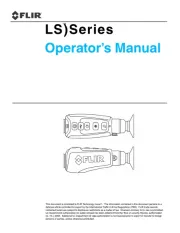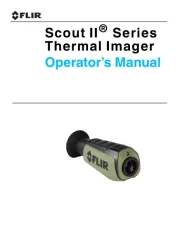Flir Oryx Handleiding
Flir
Niet gecategoriseerd
Oryx
Bekijk gratis de handleiding van Flir Oryx (2 pagina’s), behorend tot de categorie Niet gecategoriseerd. Deze gids werd als nuttig beoordeeld door 46 mensen en kreeg gemiddeld 4.7 sterren uit 23.5 reviews. Heb je een vraag over Flir Oryx of wil je andere gebruikers van dit product iets vragen? Stel een vraag
Pagina 1/2

GETTING
GETTING
GETTING
GETTINGGETTING
STARTED
STARTED
STARTED
STARTEDSTARTED
ORYX®
GigE Vision
Will
Will
Will
WillWill your
your
your
youryour system
system
system
systemsystem support
support
support
supportsupport the
the
the
thethe camera?
camera?
camera?
camera?camera?
Recommended System Configuration:
nOS—Windowsor Linux (32- or 64-bit)
nCPU— Intel i7 or greater
nRAM—8 GB dual channel
nPorts—10GBASE-T network adapter
nSoftware—Microsoft Visual Studio 2010, Visual Studio 2013, or Visual Studio
2015 (to run and compile example code)
Do
Do
Do
DoDo you
you
you
youyou have
have
have
havehave a
a
a
aa downloads
downloads
downloads
downloadsdownloads account?
account?
account?
account?account?
A downloads account is required to download software and firmware.
1. Go to .www.flir.com/account
2. Enter your email address and click Continue.
3. Complete the Create an account form and click Continue.
4. You will receive an email with a link to activate your account.
5. Once activated, you can login using the credentials you've created.
The has many resources to help you operate your cameraOryx resources page
effectively, including:
nSpinnaker®SDKsoftware, including drivers (login required)
nFirmware updates and release notes (login required)
nDimensional drawings and CADmodels
nDocumentation
Do
Do
Do
DoDo you
you
you
youyou have
have
have
havehave all
all
all
allall the
the
the
thethe parts
parts
parts
partsparts you
you
you
youyou need?
need?
need?
need?need?
To install your camera you need the following components:
nEthernet cable
nGPIOcable
nLens
nTripod adapter (optional)
nInterface card
Teledyne FLIR sells a number of the additional parts required for installation. To
purchase, visit the .Accessories page
Camera
Camera
Camera
CameraCamera Care
Care
Care
CareCare
To clean the imaging surface of your camera, follow the steps outlined in Cleaning
the imaging surface of your camera.
Extended exposure to bright sunlight, rain, dusty environments, etc. may cause
problems with the electronics and optics of the system.
Avoid excessive shaking, dropping, or mishandling of the device.
Warning! Avoid electrostatic charging.
Installing
Installing
Installing
InstallingInstalling Your
Your
Your
YourYour Interface
Interface
Interface
InterfaceInterface Card
Card
Card
CardCard and
and
and
andand Software
Software
Software
SoftwareSoftware
1. Install your Interface Card
Ensure the card is installed per the
manufacturer's instructions.
Connect the internal IDE or SATApower
connector on the card to the computer power
supply.
Alternatively, use your PC's built- in host
controller, if equipped.
Open the Windows Device Manager. Ensure the card is properly installed. Ethernet
cards appear under . An exclamation point (!) next to the cardNetwork Adapters
indicates the driver has not yet been installed.
2. Install the Spinnaker® Software
Note: For existing users who already have Spinnaker installed, we recommend
ensuring you have the latest version for optimal performance of your camera. If
you do not need to install Spinnaker, use SpinView to install and enable drivers
for your card.
a. Go to the page.Spinnaker SDK
b. Click the Download button. You are prompted to login, if not already.
c. Select your operating system. Depending on your selection there may be other
versions to select.
d. After download is complete, open the file to start the Spinnaker setup wizard.
e. Follow the steps in each setup dialog.
3. Enable jumbo frames on the Ethernet card
a. In , right click on the NetworkStart->All Programs-> Spinnaker SDK->SpinView
Adapter and select Adapter Configuration, then select IP Configuration.
b. Click Open Network Connections.
c. Click Change Settings.
d. Click on the Advanced tab and from the Settings list select Jumbo Packet.
e. Set the Value to 9014 Bytes and click OK.
See for more information onHow to Optimize GigENetwork Adapter Settings
configuring for best performance.
Using
Using
Using
UsingUsing the
the
the
thethe Spinnaker
Spinnaker
Spinnaker
SpinnakerSpinnaker®
®
®
®® SDK
SDK
SDK
SDKSDK
You can monitor or control features of the camera through Spinnaker API examples
provided in the Spinnaker SDK, or through the SpinView camera evaluation
application. A is included in the installation.Programmer's Guide and API Reference
11/29/2022
Names and marks appearing on the products herein are either
registered trademarks or trademarks of FLIR Systems, Inc. and/or its
subsidiaries.
© 2015-2022 FLIR Integrated Imaging Solutions Inc. All rights
reserved.

Installing
Installing
Installing
InstallingInstalling Your
Your
Your
YourYour Oryx
Oryx
Oryx
OryxOryx 10GigE
10GigE
10GigE
10GigE10GigE
1. Attach a Lens
Unscrew the dust cap from the lens holder to install a lens.
2. Connect the interface Card and Cable to the Camera
Plug the interface cable into the host controller card and the camera. The
cable jack screws can be used for a secure connection.
When the camera is first connected, the operating system automatically installs
the camera driver. Camera drivers are available with the Spinnaker SDK
installation.
3. Plug in the GPIO connector
GPIOis used for power, trigger, serial input output, and strobe.
4. Confirm Successful Installation
Run the SpinView application: Start->All Programs-> Spinnaker->SpinView
The SpinView application can be used to test the camera's image acquisition
capabilities.
5. Configure IPSettings if necessary
By default, a dynamic IPaddress is assigned to the camera according to the
DHCP protocol. If DHCP addressing fails, a link- local address is assigned. If
necessary, in SpinView change the IPaddress of the camera to be on the same
subnet as the NIC.
Changes to your camera's installation configuration can be made using the
SpinView application.
Status
Status
Status
StatusStatus Indicator
Indicator
Indicator
IndicatorIndicator LED
LED
LED
LEDLED
LED 10GigE
No Light No power
or LED is in inactive state
or LED is in error status state with no error
Blinking Green (1 blink) Link-Local Address (LLA)
Blinking Green (2 blinks) DHCPIPAddress
Blinking Green (3 blinks) Persistent IPAddress
Solid Green Acquisition Started
Rapid Flashing Green Firmware update in progress
Flashing Green and Red General Error
Network
Network
Network
NetworkNetwork Status
Status
Status
StatusStatus LEDs
LEDs
LEDs
LEDsLEDs
No Light No network connection
Left and Right Bright Green 10 GigE connection
Left Dim and Right Bright Green 1 GigE connection
Left and/or Right Blinking Green Data transfer in progress
Camera
Camera
Camera
CameraCamera Interface
Interface
Interface
InterfaceInterface
Ethernet
Ethernet
Ethernet
EthernetEthernet Connector
Connector
Connector
ConnectorConnector
The 8-pin RJ-45 Ethernet jack is equipped with two (2) M2 screwholes for secure
connection. Pin assignments conform to the Ethernet standard.
General
General
General
GeneralGeneral Purpose
Purpose
Purpose
PurposePurpose I/O
I/O
I/O
I/OI/O Connector
Connector
Connector
ConnectorConnector
The camera is equipped with a 12-pin GPIO connector on the back of the case.
Small, Standard, and Large Case Models
Color Pin Line Function Description
Black 1 N/A GND DCcamera power ground
White 2 N/A POWER DCcamera power
Red 3 Line 1 GPIO_OPT_
OUT1 Opto-isolated output (GPO1)
Green 4 Line 4 GPIO_OPT_
OUT2 Opto-isolated output (GPO2)
Orange 5 Line 0 GPIO_OPT_IN1 Opto-isolated input (GPI1)
Blue 6 Line 3 GPIO_OPT_IN2 Opto-isolated input (GPI2)
White with
black stripes 7 Line 2 GPIO_TTL_IO3 TTL input/output 3*
Red with black
stripes 8 Line 5 GPIO_TTL_IO4 TTL input/output 4*
Green with
black stripes 9 N/A GND DC camera power ground
Orange with
black stripes 10 N/A POWER DC camera power
Blue with
black stripes 11 Line 6 3.3 VOUTPUT +3.3 V output, current 120 mA (nominal) - firmware
enabled
Black with
white stripes 12 N/A OPTO_GND Ground for opto-isolated I/O, not connected to
camera ground
*When configured as output line format is open drain, not TTL. Users should attach their own external
pull-up resistor.
For
For
For
ForFor More
More
More
MoreMore Information
Information
Information
InformationInformation
Teledyne FLIR endeavors to provide the highest level of technical support
possible to you.
Support resources can be accessed through the .Oryx resources page
Your camera's settings and capabilities—Technical Reference or Camera Reference
Spinnaker® SDK—API Reference / Programmer's Guide
Selecting a lens for your camera
10GigE Best Practices: Setting Up a Single-camera System
Using third-party applications from our software partners
Contacting
Contacting
Contacting
ContactingContacting Us
Us
Us
UsUs
For any questions, concerns or comments please contact us via the following
methods:
Email General questions
Support Ticket Technical support
Website Find specifications, support articles, downloads on the
product page at Teledyne FLIRmachine vision
11/29/2022
Names and marks appearing on the products herein are either
registered trademarks or trademarks of FLIR Systems, Inc. and/or its
subsidiaries.
© 2015-2022 FLIR Integrated Imaging Solutions Inc. All rights
reserved.
Product specificaties
| Merk: | Flir |
| Categorie: | Niet gecategoriseerd |
| Model: | Oryx |
Heb je hulp nodig?
Als je hulp nodig hebt met Flir Oryx stel dan hieronder een vraag en andere gebruikers zullen je antwoorden
Handleiding Niet gecategoriseerd Flir

1 Mei 2025

29 Maart 2025

11 Maart 2025

11 Maart 2025

11 Maart 2025

11 Maart 2025

11 Maart 2025

11 Maart 2025

25 Februari 2025

30 Januari 2025
Handleiding Niet gecategoriseerd
- Muller
- Yamazen
- Really Right Stuff
- NZXT
- ICU
- PXN
- Sikkens
- Meradiso
- Atech Flash Technology
- Tovsto
- Hanwha
- Tenda
- OneSpan
- AutoParkTime
- Hitron
Nieuwste handleidingen voor Niet gecategoriseerd

14 September 2025

14 September 2025

13 September 2025

13 September 2025

13 September 2025

13 September 2025

13 September 2025

13 September 2025

13 September 2025

13 September 2025